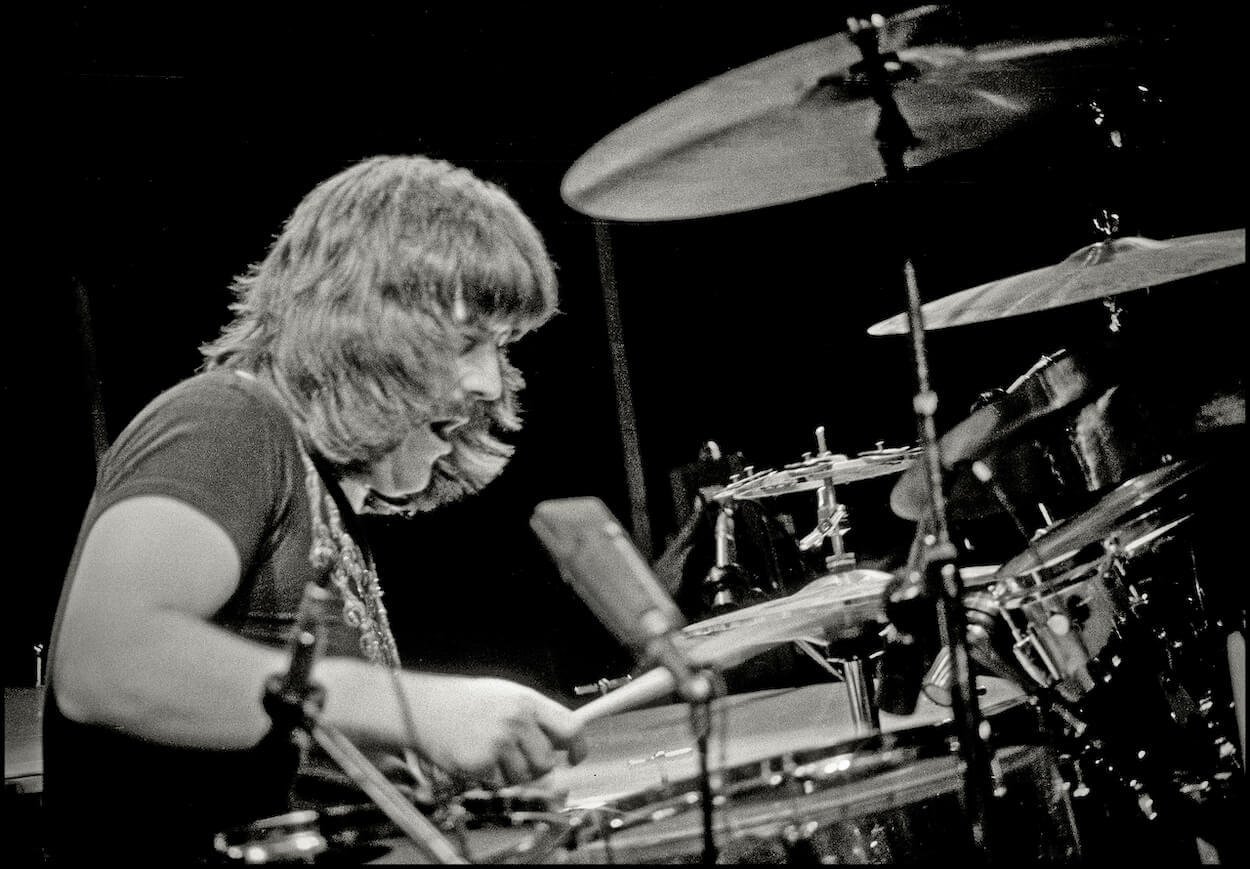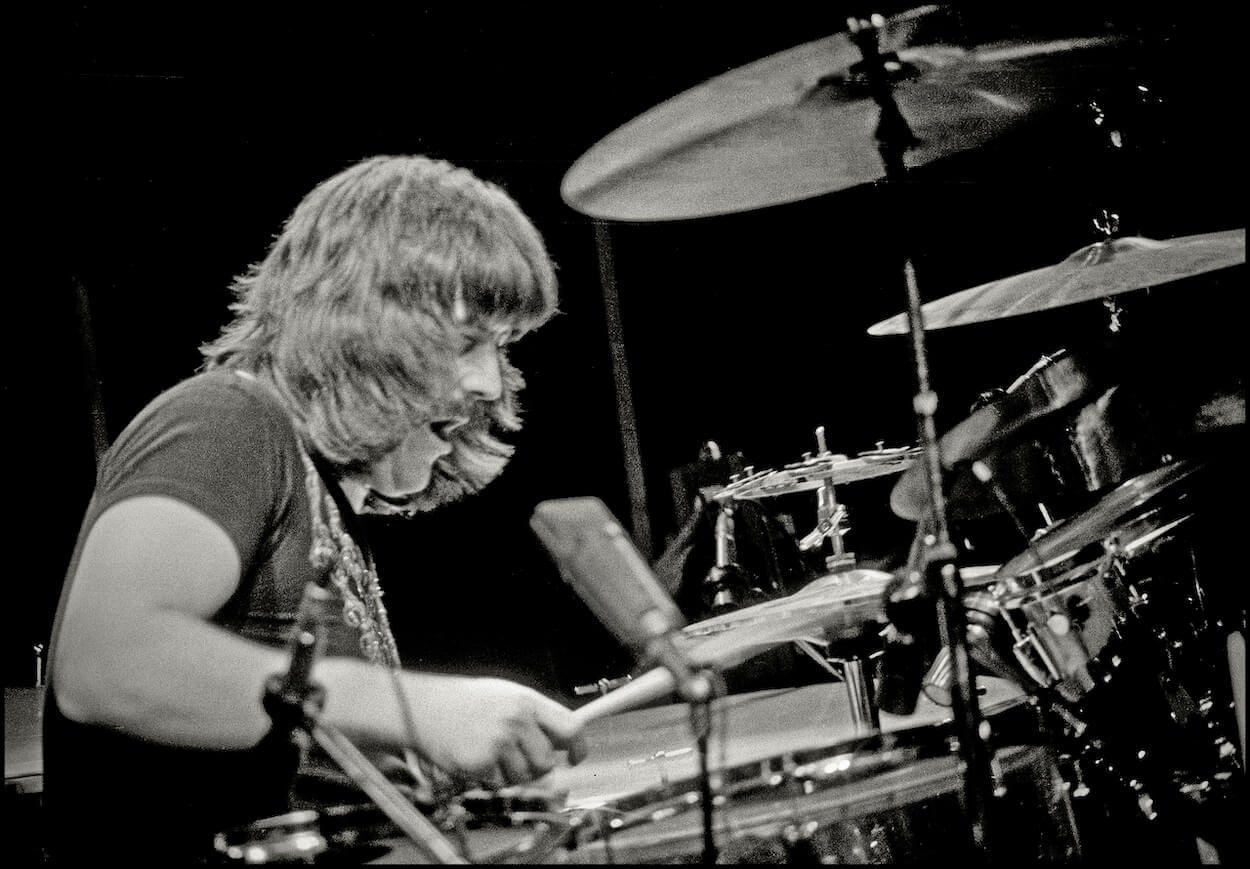
Led Zeppelin: 5 Secret Tricks John Bonham Used to Create His Signature Drum Sound
Most classic rock fans consider Led Zeppelin drummer John Bonham one of the best. He didn’t get the credit he deserved at the time, and he was a specific target for one of the musicians who hated the band, but hindsight tells us his playing was almost impeccable. Far from being a hard hitter, Bonham used five tricks to achieve his drum sound in Led Zeppelin.

John Bonham developed the tricks he used in Led Zeppelin as a self-taught drummer
Bonham never received formal drum lessons. He started banging away on items around the house as a child before graduating to a real kit. He played alongside other drummers, including a mentor who never thought he was good, and picked things along the way, but Bonham developed his own tricks to achieve his sound.
Bonzo sounded like Bonzo no matter what drum kit he sat behind. That was one of the traits that led Zep bassist John Paul Jones to praise Bonham’s drumming. It wasn’t about hitting hard — Bonham’s tricks made Led Zeppelin’s drummer one of the best ever.
1. Bonham’s positioning behind the kit
If it sounded like Bonham was about to put his hands through the drum heads with each beat, that’s because he was close enough to do so.
Bonham sat very low behind his kit. It was a nod to his jazz influences and a departure from how most rock drummers positioned themselves. Watch fellow forceful drummer Keith Moon of The Who (via YouTube) playing, and he’s sitting well above his snare. Meanwhile, Bonham sat so low that the snare was practically in his lap. His positioning was one of the little nuances that helped Bonham achieve his Led Zeppelin drum sound.
2. Bonzo tuned his drums
Drummers can tune their instruments just as guitarists and bassists do. Tightening or loosening the drum heads alters the sound. Bonham was one of the few drummers who utilized that ability to tune his instrument. And he was one of the only drummers who could do it himself, which set him apart from other rock drummers of his era.
3. Bonham’s grip was one of his secret tricks
Most drummers follow instinct and grip their sticks at the very bottom. One of the tricks Bonham employed was holding his sticks nearly halfway up. The instinctive grip makes for more of a pendulum swinging through the drum heads. Yet the drummer loses some of the momentum of the swing when the stick meets the head.
Bonham’s tighter grip further up the stick allowed for a more forceful thud on the drum heads instead of a lighter tap. Coupled with his low seat behind the kit, it was one of Bonham’s lesser-known tricks that helped him achieve a big drum sound with Led Zeppelin.
4. He used bigger drums
His grip, positioning, and tuning weren’t Bonham’s only drumming tricks. Learning that he used the largest drums possible is the one that most clearly comes through the speakers when you listen to Led Zeppelin.
Bonzo always opted for the biggest drums for his kit. The larger depth and circumference, combined with his other tricks, helped Bonham achieve a larger-than-life sound. He adopted Ludwig’s Vistalite acrylic drums when the company introduced them in the 1970s. Ludwig still sells a Zep kit with a 14×26-inch bass drum (larger than the standard 14×24), 10×14 mounted tom (versus 9×13), and a 16×18 floor tom (vs. 16×16).
5. Studio miking helped Bonham create his signature sound
Miking the kit wasn’t up to him, but it was one of the secret tricks that helped make Bonham’s drums sound larger than life. Recording engineer Glyn Johns worked on only one Led Zeppelin album (their debut), but he accidentally unlocked a secret to creating Bonzo’s massive sound.
As he explained in his memoir Sound Man (via Far Out), Johns typically used three or four drum mics on most songs. During one session, he used a drum mic to record an acoustic guitar for another track. When Johns listened back to the acoustic guitar track, the drum sound remained on the left channel with the guitar but also in the middle channel on their own. That led Johns to try using two mics equidistant and a little farther from the kit to record drums.
Johns stumbled on the idea of stereo drums.
Placing mics a little farther from the kit gave the drum sound room to expand. Bonham’s positioning, grip, larger drums, and tuning skills coupled with Johns’ stereo innovation made Bonzo’s drums sound massive.
Bonham’s vision for his drumming was to have his playing accompany the lead guitar, not play behind it. The way Led Zeppelin recorded and mixed their albums helped him make his vision a reality, but Bonham’s tricks of the trade played a big part in creating his signature sound.
For more on the entertainment world and exclusive interviews, subscribe to Showbiz Cheat Sheet’s YouTube channel.


